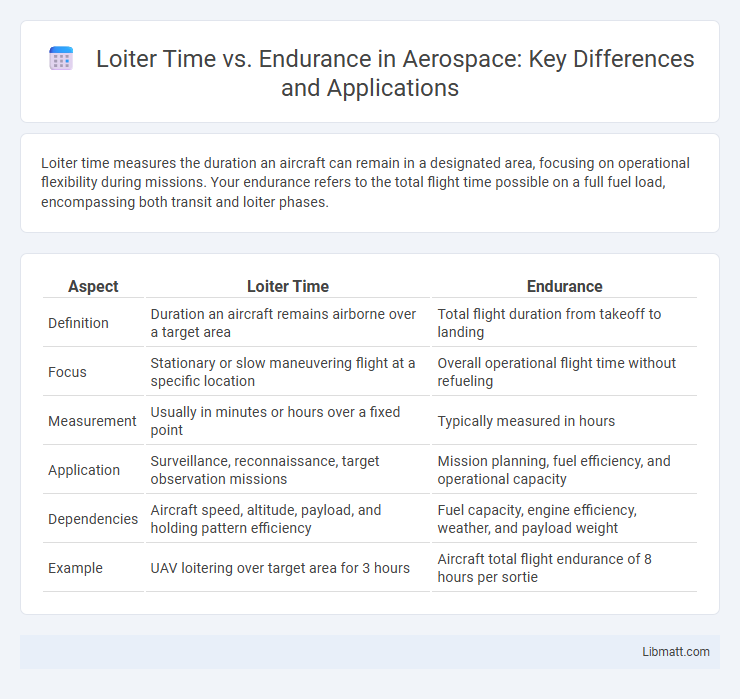Loiter time measures the duration an aircraft can remain in a designated area, focusing on operational flexibility during missions. Your endurance refers to the total flight time possible on a full fuel load, encompassing both transit and loiter phases.
Table of Comparison
| Aspect | Loiter Time | Endurance |
|---|---|---|
| Definition | Duration an aircraft remains airborne over a target area | Total flight duration from takeoff to landing |
| Focus | Stationary or slow maneuvering flight at a specific location | Overall operational flight time without refueling |
| Measurement | Usually in minutes or hours over a fixed point | Typically measured in hours |
| Application | Surveillance, reconnaissance, target observation missions | Mission planning, fuel efficiency, and operational capacity |
| Dependencies | Aircraft speed, altitude, payload, and holding pattern efficiency | Fuel capacity, engine efficiency, weather, and payload weight |
| Example | UAV loitering over target area for 3 hours | Aircraft total flight endurance of 8 hours per sortie |
Introduction to Loiter Time and Endurance
Loiter time refers to the duration an aircraft or UAV can remain over a specific area without landing, while endurance measures the total flight time before refueling or battery depletion. These metrics are critical for mission planning and operational efficiency, especially in surveillance, reconnaissance, and search-and-rescue missions. Understanding the distinction between loiter time and endurance helps optimize your aerial platform's performance to meet mission-specific demands.
Defining Loiter Time in Aviation
Loiter time in aviation refers to the duration an aircraft can remain airborne within a specified area while maintaining a specific flight pattern or holding position. It is a critical metric for missions requiring prolonged observation, surveillance, or waiting for further instructions before proceeding. Understanding loiter time helps optimize your flight operations by balancing fuel consumption and mission requirements.
Understanding Endurance in Aircraft Performance
Endurance in aircraft performance refers to the maximum time an aircraft can remain airborne on a fixed fuel load while loiter time specifically measures how long an aircraft stays within a target area during a mission. Endurance is primarily influenced by fuel efficiency, payload weight, and engine performance, which together determine the aircraft's capability to sustain prolonged flight. Understanding these factors is crucial for optimizing missions requiring extended flight durations, especially in surveillance or reconnaissance operations.
Key Differences Between Loiter Time and Endurance
Loiter time refers to the duration an aircraft or drone can remain in a specific area performing a mission without landing, while endurance measures the total flight time from takeoff until fuel exhaustion or battery depletion. Endurance is influenced by factors such as fuel capacity, engine efficiency, and payload weight, whereas loiter time emphasizes operational efficiency during stationary or low-speed maneuvers. Understanding these distinctions is vital for optimizing mission planning and resource allocation in aviation and unmanned aerial vehicle (UAV) operations.
Factors Affecting Loiter Time
Loiter time depends primarily on fuel capacity, engine efficiency, and payload weight, which directly influence how long an aircraft can stay airborne without landing. Weather conditions, such as wind patterns and temperature, also significantly impact endurance by altering fuel consumption rates. Understanding these factors helps you optimize mission planning and maximize operational efficiency for specific flight profiles.
Elements Influencing Aircraft Endurance
Aircraft endurance depends heavily on fuel capacity, engine efficiency, and aerodynamic design, which collectively determine how long your aircraft can remain airborne. Environmental factors such as wind conditions and temperature also play a critical role in influencing loiter time by affecting fuel consumption and overall performance. Optimizing these elements ensures maximum endurance, allowing for extended operational periods during missions or flights.
Practical Applications of Loiter Time
Loiter time is the duration an aircraft or drone remains in a specific area before proceeding with a mission, directly impacting surveillance and reconnaissance effectiveness. Practical applications of loiter time include extended aerial monitoring in military operations, search and rescue missions, and environmental data collection, where sustained presence improves situational awareness. Optimal loiter time ensures continuous coverage without compromising fuel efficiency, balancing mission requirements with endurance limits.
Significance of Endurance in Mission Planning
Endurance in mission planning is crucial as it determines the maximum duration an aircraft can stay airborne, directly impacting the ability to complete long-duration tasks or cover extended operational areas. High endurance enhances strategic flexibility by allowing prolonged surveillance, reconnaissance, or patrol without the need for immediate refueling or replacement. Missions requiring sustained presence, such as search and rescue or intelligence gathering, rely heavily on endurance to improve effectiveness and operational success.
Calculating Loiter Time vs Endurance: Methods and Formulas
Calculating loiter time involves determining the duration an aircraft can maintain a specific pattern or altitude over a fixed point, using the formula Loiter Time = (Fuel Available for Loiter) / (Fuel Flow Rate during Loiter). Endurance, on the other hand, measures total flight duration from takeoff to landing, calculated by Endurance = Total Fuel / Average Fuel Consumption Rate. Understanding your aircraft's fuel capacity, consumption rates, and mission profile is essential to accurately apply these formulas for effective flight planning.
Conclusion: Choosing Between Loiter Time and Endurance
Loiter time and endurance are critical factors in evaluating UAV performance, with loiter time emphasizing the ability to remain stationary over a target area and endurance focusing on total operational duration. Selecting between them depends on mission priorities; loiter time is essential for surveillance and persistent observation, while endurance suits long-range or extended activities. Understanding these distinctions ensures optimal UAV deployment tailored to specific operational needs.
Loiter time vs Endurance Infographic

 libmatt.com
libmatt.com